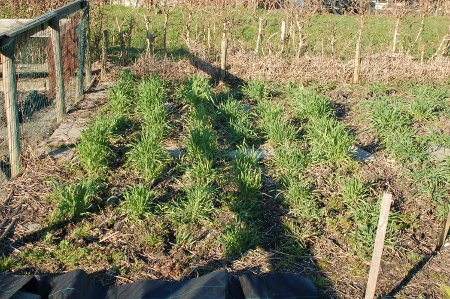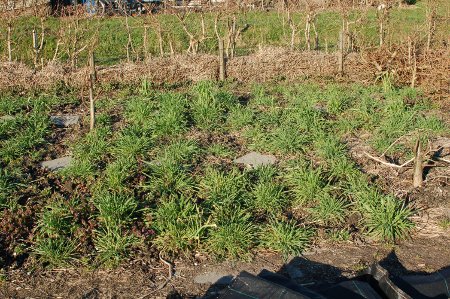About the only thing growing in the garden right now is the perennial rye from Tim Peters I posted about before last November, last September and June 2009.
The crowns are growing pretty strong now, and since I expect this to grow to about 2 meters high, I’m expecting to see a lot of rapid growth soon.
This is line #1 (the 5 rows on the left):
This is line #2 (6ish rows in the middle):
and this is line #3 (not very well defined rows, but everything to the right of the 2 paving stones on the left and not the plants along the left edge of the picture):
They all look similar, but different. As expected there is also a lot of variability between the plants.
Now is a time I might try to do some selection. I understand from Tim the crowns can be divided at this stage to make more plants. I might be able to take pieces of selected crowns for growing in an isolated spot.
Rye requires a pollination partner, so if I take exactly 2 plants to an isolated place, they will cross in a controlled way.
Another thing I might do at this stage is rogue out weak plants, so they won’t pollinate the others. I might fill the spaces with crowns from other plants.
I have some other garden space, so I might divide some crowns into it, but it’s not isolated from this space, so I would have to destroy what’s left here to keep it from crossing.
Anyone have any suggestions?





Patrick,
at the stage shown, 1st year – spring, one would rogue out the off-type plant habits or at least mark the most obvious with a marker into the clump.
This is not the stage to divide the clumps, that time is after harvest once regrowth gets some size to it, usually Aug-Sept. in Oregon USA.
Also,
The time to select the plants to use for an extra select seedgroup is at near seed maturity. go thru the patch and pull the heads of a plant together to look at the seedset, if it looks-feels good-heavy then use masking tape to pull the heads into a bunch and at harvest mark the heads and bases with the same number-code so at thresh when you best see the seed quality you can pair up the ones with best similar traits, i.e. white seed, plump seed, heaviest seed production, etc.
you will notice some strains grow more upright and others grow more prostrate
…to get pure seed you could put heads from a couple three neighboring plants into one head envelope before they shed pollen.
Hey,
If it grows 5 ft tall I think it require way, way more spacing.
Hi Ion,
Thanks for the comment.
Actually it’s a bit like saying grass needs lots of space. As a perennial plant, over time the plants will grow to fill the space between them. There’s not much you can do about how close they are.
For the first year a spacing of 30cm/1ft is about right, because after the first season there’s still enough space between the plants to distinguish them for transplant or removal.
Hi,
I don’t know how this specie behave. Actually I am looking for seeds of it for years since I read S. Holzer’s book (is it the same perennial rye that he uses ?).
I think it ends up forming a sort of little permanent bush no ? Maybe the tillering is not as intense as a real multicaule rye (up to 190 stalks when spaced 2 ft apart in all directions to give maximum sunlight, still I don’t think it is spaced enough and the underground part may compet)
I don’t know if this is the same as S. Holzer’s plant, but a lot of people seem to think it’s similar.
If anyone reading this has grown Sepp’s variety, please let us know what you think.
Tillering on my plants is much less, maybe 50 or so at the very most. Yes, it does sort of end up forming a sort of bush, a crown actually (that can be divided and replanted), but it also spreads over time like grass.
Maybe you could encourage tillering by sowing in a hole with some gravel underneath the sowing layer or around the root ball, and earthing up gradualy, 3 times, 1.5 inch every 15 days, starting at a strong 3 leaf stage -forming a mound 1 ft in diameter 1.5 inch high in the end.